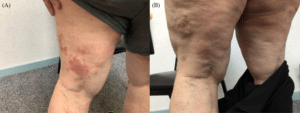Syed Minhaj Rahman1*, Fahad Ahmed2, Adel Haque3,4
1College of Medicine, University of Rochester School of Medicine and Dentistry, Rochester, New York, USA
2Department of Dermatology, Perelman School of Medicine, University of Pennsylvania, Philadelphia, Pennsylvania, USA
3Pennsylvania Dermatology Partners, Yardley, Pennsylvania, USA
4Department of Medicine, Jefferson Health Northeast, Philadelphia, Pennsylvania, USA
*Correspondence author: Syed Minhaj Rahman, College of Medicine, University of Rochester School of Medicine and Dentistry, Rochester, New York, USA; Email: [email protected]
Published Date: 31-12-2023
Copyright© 2023 by Rahman SM, et al. All rights reserved. This is an open access article distributed under the terms of the Creative Commons Attribution License, which permits unrestricted use, distribution, and reproduction in any medium, provided the original author and source are credited.
Abstract
Upadacitinib is a selective JAK-1 inhibitor initially approved for the treatment of rheumatoid arthritis and recently psoriatic arthritis (PsA). We present a patient with Atopic Dermatitis (AD), Psoriasis (PsO), PsA and Alopecia Areata (AA) refractory to multiple agents however, successfully treated with upadacitinib. Our patient initially presented with refractory PsO and PsA, leading to treatment with ixekizumab. However, subsequent development of pruritic, erythematous scaly lesions, along with AA, prompted a shift to dupilumab. When distressing PsA and suboptimal outcomes with previous treatments persisted, prior biologics were discontinued and upadacitinib was initiated. Over a three-month period, the patient achieved complete clearance of PsO, significant improvement in AA and resolution of her PsA and AD. This report highlights the therapeutic benefits of upadacitinib in treating inflammatory cutaneous conditions like AA and PsO and further suggests a need for clinical trials to explore its broad therapeutic spectrum.
Keywords: Atopic Dermatitis; Psoriasis; Alopecia Areata; Upadacitinib
Introduction
The JAK-STAT pathway has been implicated in the pathogenesis of numerous autoimmune and inflammatory conditions such as Atopic Dermatitis (AD), Psoriasis (PsO), rheumatoid arthritis and Alopecia Areata (AA) [1,2]. Upadacitinib is a selective JAK-1 inhibitor initially approved for the treatment of rheumatoid arthritis and recently further expanded to treat Psoriatic Arthritis (PsA), ankylosing spondylitis, ulcerative colitis and AD [3]. Upadacitinib has been reported in few case studies for the treatment of AA however, it has not been indicated for treatment of plaque PsO [4,5]. We present a patient with AD, PsO, PsA and AA refractory to multiple agents however, successfully treated with upadacitinib.
Case Report
A 54-year-old female with past medical history significant for diabetes mellitus, asthma, plaque PsO and psoriatic arthritis presented to our clinic in March 2022 for follow-up of her chronic plaque PsO. Her physical exam was notable for several guttate papules and psoriasiform plaques with micaceous scale of her bilateral knees, elbows and hands present on 35% of her body surface area (Fig. 1). Previous treatments for patient’s PsO included multiple topical corticosteroids and calcipotriene with minimal improvement. She was also significantly inflicted with PsA with severe involvement of the hands, elbows and knees. Due to her increasing PsO disease severity refractory to conventional topical therapies along with her severe PsA, she was started on ixekizumab (160 mg subcutaneous first dose; 80 mg on weeks 2, 4, 6, 10 and 12; 80 mg every 4 weeks after that).
In July 2022, the patient presented with significantly pruritic, erythematous scaly lesions localized to the flexural surfaces of the body including the bilateral knees, elbows and extending to the forehead, left superior lip and hands. She had trialed a topical regimen of 0.1% triamcinolone and tacrolimus 0.1% without improvement and was diagnosed with AD (Physician Global Assessment (PGA) score 3.0). Although her PsO and PsA were moderately improved from her prior visit (<25%), at this visit, she also presented with a discrete non-scarring patch of hair loss on the left scalp and was diagnosed with AA (Fig. 2). The patient was started on a trial of dupilumab (600 mg subcutaneous first dose; 300 mg every two weeks after that) with continued adherence to ixekizumab.
At her 2 week follow up appointment, she noted that her PsO had remained stable on her extensor surfaces, her AD had cleared entirely, however she was now experiencing significant distress with a worsening of the PsA in her hands and elbows. Her AA had not changed at this time. Given her concomitant conditions including AD and PsA, ixekizumab and dupilumab were discontinued and she was started on oral updacitinib 15 mg extended release, once daily. At her follow up appointment three months later, she reported complete clearance and significant clinical improvement in all four of her diagnoses notably including her PsO and AA. Her PsO had resolved with no active psoriatic patches and no flares in the interim (Fig. 1).
Regarding her AA, trichoscopy demonstrated regrowth of hair in previous area of scalp involvement and no signs of new disease activity (Fig. 2). She continued without any PsO patches and had continued improvement with her AA at most recent follow-up in February 2023. Upadacitinib therapy was well tolerated without any side effects; laboratory testing included complete blood count, comprehensive metabolic panel, liver function tests, lipid panel, hepatitis serology and tuberculosis screenings prior to drug initiation.

Figure 1: Clinical image of patient’s left flexor leg surface A) demonstrating psoriatic plaques before treatment with upadacitinib, followed by B) after 6 months of treatment.

Figure 2: Clinical image of patient’s scalp with discrete patch of hair loss due to alopecia areata A) before treatment with upadacitinib, followed by B) after 6 months of treatment.
Discussion
We present a patient inflicted with chronic plaque PsO refractory to multiple interventions yet was successfully treated with upadacitinib, a JAK-1 inhibitor. Patient additionally presented with co-existing inflammatory conditions including AD, AA and PsA all of which significantly improved upon administration of upadacitinib. Although upadacitinib has been recently expanded in the treatment for AD and PsA, there is currently no indication for its treatment in plaque PsO or AA.
Upadacitinib has been reported in improving and/or treating eight patients with AA, five of whom had co-existing AD. AA and AD have shown to be involved in a common downstream signaling cascade moderated by JAK-1, specifically involving Interleukin (IL)-4, IL-15, IL-6 and interferon-G.6,7 Although JAK-1 moderates multiple downstream inflammatory processes, it is possible that the treatment of AD in those patients with co-existing AD and AA, may indirectly improve AA symptoms, or may be the result of two isolated pathways.6 Considering that upadacitinib has been approved for AD, the commonalities between AD and AA in disease pathway, existing cited literature and the current reported case, this should prompt further research involving the potential therapeutic benefit of upadacitinib in treating AA.
There is limited research reporting upadacitinib’s therapeutic benefit in treating PsO. Gargiulo, et al., recent case series reported four patients with concomitant plaque PsO and AD who failed several biological drugs, including gold-standard therapies, only to achieve complete remission with upadacitnib.5 PsO and AD’s chronic inflammatory nature do not overlap in their current understood pathogeneses, as PsO is primarily due to a Th-17 inflammation while AD is fueled by a type 2 inflammatory pattern.5 Therefore, the resolution of plaque PsO in our patient with concomitant AD is a unique presentation.
Conclusion
Our case adds to the growing body of literature regarding the therapeutic benefits of upadacitinib in patients with AA with or without co-existing AD.6 This report fortifies the rationale regarding the need for larger clinical trials in examining the full spectrum of upadacitinib’s therapeutic effects, specifically in AA and PsO.
Informed Consent
We have obtained explicit written informed consent from the patient to publish this anonymized case report.
Ethics Statement
Our institution does not require ethics approval for reporting case studies.
Conflict of Interest
The authors have no conflict of interest to declare.
References
- Motamed-Sanaye A, Khazaee YF, Shokrgozar M, Alishahi M, Ahramiyanpour N, Amani M. JAK inhibitors in lichen planus: a review of pathogenesis and treatments. J Dermatological Treatment. 2022;33(8):3098-103.
- Huang IH, Chung WH, Wu PC, Chen CB. JAK–STAT signaling pathway in the pathogenesis of atopic dermatitis: An updated review. Front Immunol. 2022;13:1068260.
- Padda IS, Bhatt R, Parmar M. Upadacitinib. In: StatPearls. StatPearls Publishing; 2023. [Last accessed on: December 25, 2023]. http://www.ncbi.nlm.nih.gov/books/NBK572088/
- Gargiulo L, Ibba L, Pavia G. Upadacitinib for the treatment of concomitant psoriasis and atopic dermatitis: a case series. Journal of Dermatological Treatment. 2023;34(1):2183729.
- Bourkas AN, Sibbald C. Upadacitinib for the treatment of alopecia areata and severe atopic dermatitis in a paediatric patient: A case report. SAGE Open Medical Case Reports. 2022;10:2050313X2211384.
- Montilla AM, Gómez-García F, Gómez-Arias PJ, Gay-Mimbrera J, Hernández-Parada J, Isla-Tejera B, et al. Scoping review on the use of drugs targeting JAK/STAT pathway in atopic dermatitis, vitiligo and alopecia areata. Dermatol Ther. 2019;9:655-83.
Article Type
Case Report
Publication History
Received Date: 09-12-2023
Accepted Date: 25-12-2023
Published Date: 31-12-2023
Copyright© 2023 by Rahman SM, et al. All rights reserved. This is an open access article distributed under the terms of the Creative Commons Attribution License, which permits unrestricted use, distribution, and reproduction in any medium, provided the original author and source are credited.
Citation: Rahman SM, et al. Upadacitinib Efficacy for the Treatment of Concomitant Psoriasis and Alopecia Areata. J Dermatol Res. 2023;4(3):1-4.

Figure 1: Clinical image of patient’s left flexor leg surface A) demonstrating psoriatic plaques before treatment with upadacitinib, followed by B) after 6 months of treatment.

Figure 2: Clinical image of patient’s scalp with discrete patch of hair loss due to alopecia areata A) before treatment with upadacitinib, followed by B) after 6 months of treatment.


